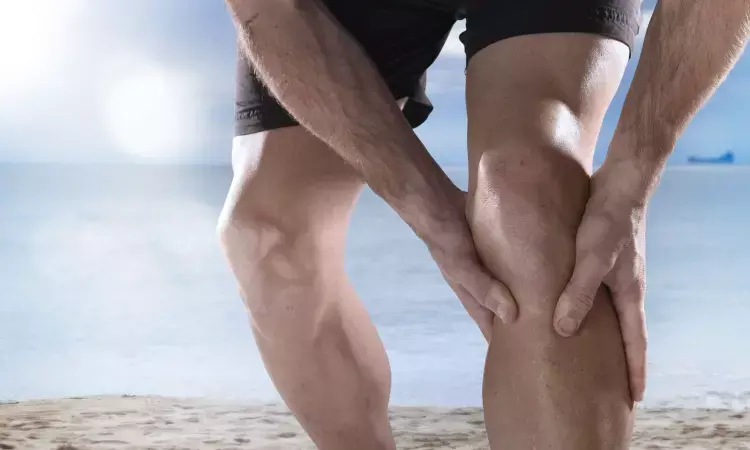- Home
- Medical news & Guidelines
- Anesthesiology
- Cardiology and CTVS
- Critical Care
- Dentistry
- Dermatology
- Diabetes and Endocrinology
- ENT
- Gastroenterology
- Medicine
- Nephrology
- Neurology
- Obstretics-Gynaecology
- Oncology
- Ophthalmology
- Orthopaedics
- Pediatrics-Neonatology
- Psychiatry
- Pulmonology
- Radiology
- Surgery
- Urology
- Laboratory Medicine
- Diet
- Nursing
- Paramedical
- Physiotherapy
- Health news
- Fact Check
- Bone Health Fact Check
- Brain Health Fact Check
- Cancer Related Fact Check
- Child Care Fact Check
- Dental and oral health fact check
- Diabetes and metabolic health fact check
- Diet and Nutrition Fact Check
- Eye and ENT Care Fact Check
- Fitness fact check
- Gut health fact check
- Heart health fact check
- Kidney health fact check
- Medical education fact check
- Men's health fact check
- Respiratory fact check
- Skin and hair care fact check
- Vaccine and Immunization fact check
- Women's health fact check
- AYUSH
- State News
- Andaman and Nicobar Islands
- Andhra Pradesh
- Arunachal Pradesh
- Assam
- Bihar
- Chandigarh
- Chattisgarh
- Dadra and Nagar Haveli
- Daman and Diu
- Delhi
- Goa
- Gujarat
- Haryana
- Himachal Pradesh
- Jammu & Kashmir
- Jharkhand
- Karnataka
- Kerala
- Ladakh
- Lakshadweep
- Madhya Pradesh
- Maharashtra
- Manipur
- Meghalaya
- Mizoram
- Nagaland
- Odisha
- Puducherry
- Punjab
- Rajasthan
- Sikkim
- Tamil Nadu
- Telangana
- Tripura
- Uttar Pradesh
- Uttrakhand
- West Bengal
- Medical Education
- Industry
AI-based CT body composition links muscle fat with mortality risk in asymptomatic adults

Belgium: Artificial intelligence-based CT body composition assessment has revealed asymptomatic adults with myosteatosis are at an increased risk of MACE (major adverse cardiovascular events), a recent study published in Radiology has shown. Myosteatosis is a high accumulation of muscle fat.
"AI–based body composition profiling from routine abdominal CT scans identified myosteatosis as a key predictor of mortality risk in asymptomatic adults," the researchers wrote in their study.
Most medical interest in body composition and its effect on health is focused on (visceral) obesity, muscle wasting, and liver steatosis, while myosteatosis is overlooked. According to the authors, myosteatosis robustly associates with prognosis in patients with chronic diseases."
Body composition is assessed using the BMI (body mass index), calculated using a person's weight and height, and most evaluation focus on liver steatosis and visceral fat. Myosteatosis is fat accumulating in the muscles, and it tends to be identified via MR or CT imaging in people who are already sick and being treated for another condition. Little research has been done on how myosteatosis affects asymptomatic individuals' health.
The team noted, "The typically silent fat accumulation in ectopic locations is now considered one of the major risk factors of mortality, independent of obesity."
Maxime Nachit, UCLouvain in Brussels, and colleagues use AI–based body composition metrics from routine abdominal CT scans in asymptomatic adults to clarify the association between obesity, myopenia, liver steatosis, and myosteatosis and mortality risk in a retrospective single-centre study.
The study included consecutive adult outpatients undergoing routine screening for colorectal cancer from 2004 to 2016. The following metrics were extracted from low-dose, non-contrast, supine multidetector abdominal CT scans: total muscle area, subcutaneous and visceral fat area, muscle density, and volumetric liver density.
Abnormal body composition was defined by obesity, liver steatosis, low muscle mass (myopenia), and muscle fatty infiltration (myosteatosis). Multivariable analyses were performed accounting for sex, age, smoking status, liver steatosis, myosteatosis, type 2 diabetes, myopenia, visceral fat, obesity, and history of cardiovascular events. During a median follow-up of 8.8 years, the incidence of death and MACE were recorded.
A total of 8982 consecutive outpatients (mean age, 57 years; 5008 female, 3974 male) were included.
The authors reported the following findings:
- Abnormal body composition was found in 86% of patients who died during follow-up.
- Myosteatosis was found in 55% of the patients who died (15.5% absolute risk at ten years).
- Myosteatosis, liver steatosis, obesity, and myopenia were associated with increased mortality risk (hazard ratio: 4.33, 1.27, 1.86, and 1.75, respectively).
- In 8303 patients (excluding 679 patients without complete data), after multivariable adjustment, myosteatosis remained associated with increased mortality risk (HR, 1.89).
"We hope that this report will contribute to making the medical community aware of myosteatosis important, which is a silent pathological condition not exclusively associated with coexisting disease," the researchers wrote.
"Mechanistic studies are required to determine whether therapeutic reduction of muscle fat and modulating plausible noxious pathways induced by myosteatosis could be novel strategies to promote healthy ageing, "they concluded.
Reference:
Nachit M, Horsmans Y, Summers RM, Leclercq IA, Pickhardt PJ. AI-based CT Body Composition Identifies Myosteatosis as Key Mortality Predictor in Asymptomatic Adults. Radiology. 2023 May 16:222008. doi: 10.1148/radiol.222008. Epub ahead of print. PMID: 37191484.
Dr Kamal Kant Kohli-MBBS, DTCD- a chest specialist with more than 30 years of practice and a flair for writing clinical articles, Dr Kamal Kant Kohli joined Medical Dialogues as a Chief Editor of Medical News. Besides writing articles, as an editor, he proofreads and verifies all the medical content published on Medical Dialogues including those coming from journals, studies,medical conferences,guidelines etc. Email: drkohli@medicaldialogues.in. Contact no. 011-43720751


